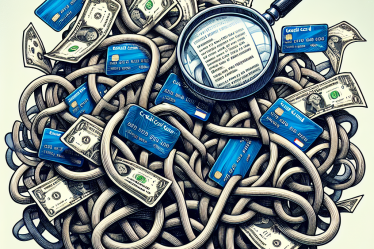
Key Insights to Keep in Mind
- If simple, straightforward rewards are your game, cash back cards tend to hit the mark with easy earning on every dollar spent.
- For those clocking frequent miles or jet-setting regularly, points or miles cards usually unlock better perks tailored toward travel.
- Can’t quite pick a side? Mixing and matching different cards and reward types might just unlock your ideal combo.
Credit card rewards come in all shapes and sizes. Whether you’re chasing cold, hard cash back or racking up points and miles for adventures, each rewards style holds its own set of perks and pitfalls. Your best bet depends on how you spend day-to-day, your lifestyle choices, and what you ultimately want to get from your plastic. Let’s unpack the nuances between these reward systems, weigh their upsides and downsides, and help you pinpoint the perfect fit for your wallet.
Cash Back Versus Points & Miles: What’s the Difference?
Cash back cards typically hand you a percentage of your spending back as cold cash. This no-nonsense reward style is user-friendly and usually sticks to straightforward redemptions, though some let you swap rewards for gift cards or shop with points at select stores.
On the flipside, points and miles cards pile up intangible currency with every swipe. You might earn points within the credit issuer’s proprietary program — like Chase Ultimate Rewards or American Express Membership Rewards — which often boast flexible redemption paths, travel included.
Then there are co-branded cards tied directly to airlines or hotel chains — think American Airlines AAdvantage or World of Hyatt — where points go straight into those specific loyalty programs. These cards are designed with travel buffs in mind, typically found among premium travelers chasing airline seats or hotel nights.
Handle points and miles shrewdly, and they can translate into significant savings on sought-after vacations.
Reward Type Breakdown
| Reward Currency | Straight-up cash back | Points or miles earned through airline/hotel or general programs |
| Earning Potential | 1%–2% cash back on usual spends; boosted to 3%+ in bonus categories | 1x–2x points on standard purchases; up to 10x or more in niches like hotels |
| Redemption Options | Cash back, statement credits, gift cards, and merchandise | Varies widely — travel bookings, partner transfers, cash back, gift cards, and more |
| Redemption Value | Usually around 1 cent per point | Ranges from 1 cent for non-travel redemptions to much higher for premium travel redemptions |
Inside Scoop on Cash Back Cards
Why Their Flexibility Shines
One standout perk of cash back cards is the freedom they give you when it’s time to cash out. Depending on your card, your rewards might roll in via mailed checks, direct deposits, or even be swapped for gift cards, merchandise, or travel bookings through your card’s portal — though the latter often comes with diminished value.
What You Get for Your Points
For those who prefer everyday savings over extravagant trips, cash back cards typically offer consistent value — about 1 cent per reward point. That means a 2% cash back card puts $2 back in your pocket on every $100 spent. The simplicity here is hard to beat.
Perks and Pitfalls
Advantages
- Rewards are straightforward to earn and redeem — no hoops to jump through.
- Value per point is typically clear and reliable.
- Loads of no-annual-fee options make these cards accessible.
- Some feature generous welcome bonuses to kickstart your rewards journey.
Drawbacks
- Travel perks? Usually not on the menu, though some cards do reward travel-related purchases.
- The ceiling on potential earnings is generally lower than with travel-focused cards.
- Redemption pathways may be narrow — sometimes just statement credits.
Points and Miles Cards: What You Should Know
If jetting off often or scouting that special getaway is your vibe, points and miles cards typically deliver more bang for your travel buck. Some reward you with points earmarked for free hotel stays, while others operate on flexible points that can be funneled toward an assortment of travel perks.
Beyond just points, these cards often pack extra goodies: airport lounge access, travel credits, or even reimbursements on application fees. Take Chase Ultimate Rewards, for instance — points here can be flexibly redeemed for cash back, travel, gift cards, or seamlessly transferred 1:1 to partner airlines and hotels.
The Nitty-Gritty of Redemption Value
Travel rewards generally eclipse cash back in value when navigated wisely. Unlike the steady 1 cent per point cash back valuation, travel redemptions flex their worth depending on how you cash them in.
Experts gauge value with the “cents per point” formula: divide the cash retail price of your flight or hotel (less taxes/fees you pay out of pocket) by the points spent. For example, burning 10,000 points plus $50 in fees on a $250 flight nets you a 2-cent-per-point value, doubling what a typical cash back redemption offers.
Programs like Chase Ultimate Rewards may sweeten the deal by boosting point value when redeeming through their travel portal.
Stretching Points With Transfer Partners
Finding the highest-value redemptions can be a bit of a treasure hunt, but patience pays off. Premium seats and luxury hotel stays, which command sky-high cash prices but ask for relatively fewer points, often yield the juiciest returns.
Take this Lufthansa business class flight from Montreal to Munich: 88,000 miles plus $59 fees when booked via United MileagePlus, versus a staggering $6,428 cash fare. That’s a phenomenal 7.2 cents per point value — a serious win for travelers craving first-class comfort.
These coveted deals are known in points-and-miles circles as “sweet spots.” They require some digging but are well worth the effort. Start familiarizing yourself with award charts and transfer partners to get the lay of the land.
Pros and Cons of Points & Miles Cards
Advantages
- Travel rewards often offer superior value for frequent flyers.
- Perks like priority boarding, free checked bags, and lounge access elevate travel experiences.
- Many travel cards waive foreign transaction fees and include travel insurance.
- Premium cards often boast higher earning rates and fat welcome bonuses.
Disadvantages
- These cards can pack steeper annual fees than cash back alternatives.
- Managing and maximizing rewards requires more legwork and savvy.
- Co-branded airline and hotel cards sometimes restrict redemption options.
Quick Stats to Consider
According to recent data, nearly 60% of credit card users opt for cash back rewards, valuing their straightforward earning and redemption. Meanwhile, 25% prefer travel rewards to maximize their getaway budgets. The remaining users juggle multiple cards to balance both benefits.
Choosing Between Cash Back and Points & Miles: Real-World Scenarios
Picture this: You want to stack up cash back on everyday buys and redeem it easily as statement credits. An American Express cash back card might fit this plan perfectly. Compared to a points card like Amex Membership Rewards, which only nets about 0.6 cents per point when redeemed for statement credits, the cash back card’s value is clearer.
Using points at checkout can eke out a slightly better return — roughly 0.7 cents per point — but still falls short of pure cash back redemption.
The American Express Gold Card offers similar redemption values, but if you’re going for a pure cash back experience, an Amex card tailored for cash back will get you that solid 1 cent per point worth when redeemed as statement credits.
Some points cards boost their travel redemption values through portal bookings or point transfers. For example, select Chase cards have historically provided a 25% to 50% bonus when booking travel via Chase Travel, an offer gradually replaced by Points Boost — a program enhancing select hotel and flight redemptions by up to 1.75x to 2x face value for Chase Sapphire Preferred and Reserve holders respectively. Yet, the old rates remain accessible until October 2027 for existing users.
For context:
- With the old system, 60,000 points could fetch $750 (Preferred) or $900 (Reserve) in travel value.
- Points Boost ups that to as much as $1,050 (Preferred) or $1,200 (Reserve) when used on select bookings.
- Redeeming for statement credits or cash back, however, remains capped at 1 cent per point.
Voices from the Field
“I lean on travel points because they unlock trips we simply wouldn’t take otherwise,” shares Sarah Gage, Bankrate managing editor.
Meanwhile, Bankrate senior editor Harlan Vaughn champions cash back: “Travel rewards can be tricky — cash back is pure bonus money, plain and simple. Don’t miss out on easy cash just because travel rewards seem complicated.”
Final Thoughts: Which Path Fits You?
If you crave simplicity and want guaranteed returns on every dollar spent, cash back cards offer a no-fuss way to pocket rewards. Conversely, if dreaming of transforming your spending into luxury flights, plush hotel stays, and travel perks excites you, points and miles cards might be your playground.
For those who enjoy fine-tuning their rewards game, bouncing between both types — or blending varied cards — can unlock a dynamic, personalized rewards portfolio. Whatever your style, there’s a credit card reward structure waiting to match your spending and travel ambition.


